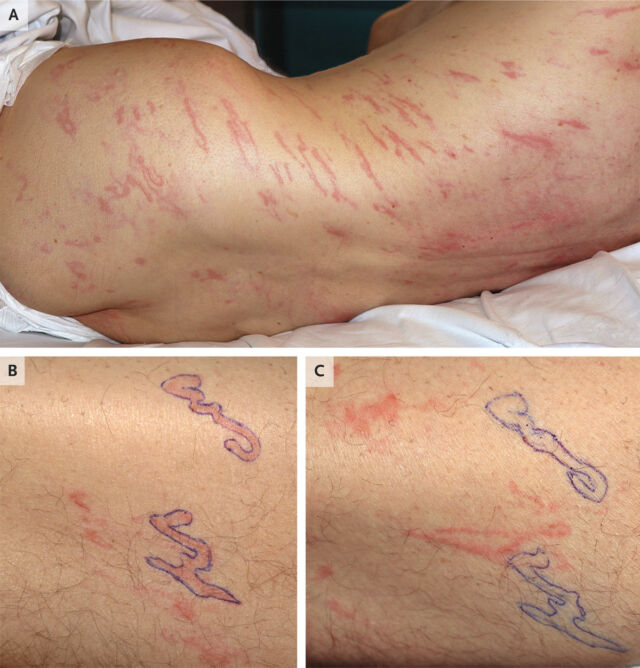
Doctors in Spain diagnosed a man with an unusual roundworm infection after seeing an army of larvae writhing and sliding under his skin, his entire body covered in an ever-changing rash.
Doctors reported the man’s rare hyperinfection this week in the New England Journal of Medicine, highlighting the unusual sight of a writhing, sliding rash that tracked the movements of individual parasitic prowlers. The official diagnosis was larval currents of: strongyloides†
The unfortunate patient seemed to have a perfect storm of risk factors for developing the unusual and unpleasant infection. The 64-year-old worked in the sewage system and had previously been diagnosed with metastatic lung cancer. Three years earlier, doctors had noted cases where he had eosinophilia — unusually high levels of disease-fighting white blood cells — which could be an indicator of a parasitic infection.
At the time of the invasion of the larvae, the man was in the hospital because a cancerous tumor began to press on his spinal cord. Doctors had treated him for several days with a high-dose glucocorticoid, which suppresses some immune responses — and creates the best conditions for parasitic worms to thrive.
Pest Invasion

The worm in this case is Strongyloides stercoralis, a nematode or roundworm known to infect humans. Infections begin when a person is exposed to contaminated soil or wastewater. The worms can mature and reproduce there, and legions of tiny larvae — about 600 micrometers in length — can emerge, burrow undetected directly into a person’s skin, and make their way to the gut by various routes. In some cases, the larvae make their way into the lungs, are coughed up and then swallowed to reach their final destination. Once in the intestines, the worms settle in the mucous membrane of the small intestine and reproduce. Larvae that hatch there are then expelled into the feces to start the process again – or invade the skin in the perianal area, resulting in an “autoinfection.”
This last, most disturbing cycle seems to have occurred in the cancer patient. Doctors noted that the problems started with a raised, itchy rash and mild diarrhea. The red, wavy skin lesions originated in his perianal area and then began to migrate under his skin, reaching down his trunk and limbs. Doctors sketched individual red squiggles on his skin with a pen and noted that 24 hours later, the squiggles had moved.
The shifting rash – and the identification of Strongyloides stercoralis larvae in a stool study – clamped the diagnosis. Doctors prescribed the man the antiparasitic ivermectin, and the rash and diarrhea improved.

